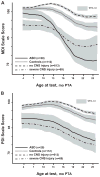Early medical and behavioral characteristics of NICU infants later classified with ASD
- PMID: 20679296
- PMCID: PMC3494479
- DOI: 10.1542/peds.2009-2680
Early medical and behavioral characteristics of NICU infants later classified with ASD
Abstract
Objectives: Recent evidence suggests higher prevalence of autism spectrum disorder (ASD) in NICU graduates. This aim of this study was to identify retrospectively early behaviors found more frequently in NICU infants who went on to develop ASD.
Methods: Twenty-eight NICU graduates who later received a diagnosis of ASD were compared with 2169 other NICU graduates recruited from 1994 to 2005. They differed in gender, gestational age, and birth cohort. These characteristics were used to draw a matched control sample (n=112) to determine which, if any, early behaviors discriminated subsequent ASD diagnosis. Behavioral testing at targeted ages (adjusted for gestation) included the Rapid Neonatal Neurobehavioral Assessment (hospital discharge, 1 month), Arousal-Modulated Attention (hospital discharge, 1 and 4 months), and Bayley Scales of Infant Development (multiple times, 4-25 months).
Results: At 1 month, children with ASD but not control children had persistent neurobehavioral abnormalities and higher incidences of asymmetric visual tracking and arm tone deficits. At 4 months, children with ASD had continued visual preference for higher amounts of stimulation than did control children, behaving more like newborns. Unlike control children, children with ASD had declining mental and motor performance by 7 to 10 months, resembling infants with severe central nervous system involvement.
Conclusions: Differences in specific behavior domains between NICU graduates who later receive a diagnosis of ASD and matched NICU control children may be identified in early infancy. Studies with this cohort may provide insights to help understand and detect early disabilities, including ASD.
Figures




Similar articles
-
Neonatal brainstem function and 4-month arousal-modulated attention are jointly associated with autism.Autism Res. 2013 Feb;6(1):11-22. doi: 10.1002/aur.1259. Epub 2012 Nov 16. Autism Res. 2013. PMID: 23165989 Free PMC article.
-
Early Developmental Trends in High-Risk Neonates Later Diagnosed With Autism Spectrum Disorder.Pediatr Phys Ther. 2023 Jan 1;35(1):28-34. doi: 10.1097/PEP.0000000000000965. Epub 2022 Sep 12. Pediatr Phys Ther. 2023. PMID: 36099519
-
Autism risk in neonatal intensive care unit patients associated with novel heart rate patterns.Pediatr Res. 2021 Dec;90(6):1186-1192. doi: 10.1038/s41390-021-01381-1. Epub 2021 Feb 18. Pediatr Res. 2021. PMID: 33603208 Free PMC article.
-
Screening for autism spectrum disorders in infants before 18 months of age.Pediatr Nurs. 2014 Jan-Feb;40(1):33-7. Pediatr Nurs. 2014. PMID: 24757919 Review.
-
Differentiating autism spectrum disorder from other developmental delays in the first two years of life.Dev Disabil Res Rev. 2011;17(2):130-40. doi: 10.1002/ddrr.1107. Dev Disabil Res Rev. 2011. PMID: 23362032 Review.
Cited by
-
Two classes of movements in motor control.Exp Brain Res. 2011 Dec;215(3-4):269-83. doi: 10.1007/s00221-011-2892-8. Epub 2011 Oct 29. Exp Brain Res. 2011. PMID: 22038712
-
Multiview child motor development dataset for AI-driven assessment of child development.Gigascience. 2022 Dec 28;12:giad039. doi: 10.1093/gigascience/giad039. Epub 2023 May 27. Gigascience. 2022. PMID: 37243520 Free PMC article.
-
Environmental factors influencing the risk of autism.J Res Med Sci. 2017 Feb 16;22:27. doi: 10.4103/1735-1995.200272. eCollection 2017. J Res Med Sci. 2017. PMID: 28413424 Free PMC article. Review.
-
Perinatal factors and the risk of bipolar disorder in Finland.J Affect Disord. 2014 Feb;155:75-80. doi: 10.1016/j.jad.2013.10.026. Epub 2013 Oct 26. J Affect Disord. 2014. PMID: 24215899 Free PMC article.
-
Arousal and attention re-orienting in autism spectrum disorders: evidence from auditory event-related potentials.Front Hum Neurosci. 2014 Feb 6;8:34. doi: 10.3389/fnhum.2014.00034. eCollection 2014. Front Hum Neurosci. 2014. PMID: 24567709 Free PMC article.
References
-
- Chakrabarti S, Fombonne E. Pervasive developmental disorders in preschool children: confirmation of high prevalence. Am J Psychiatry. 2005;162(6):1133–1141. - PubMed
-
- Centers for Disease Control and Prevention. Prevalence of autism spectrum disorders: Autism and Developmental Disabilities Monitoring Network, United States, 2000–2002. Surveill Summ MMWR. 2007;56(1):1–40. - PubMed
-
- Kogan MD, Blumberg SJ, Schieve LA, et al. Prevalence of parent-reported diagnosis of autism spectrum disorder among children in the US, 2007. Pediatrics. 2009;124(5):1395–1403. - PubMed
-
- Centers for Disease Control and Prevention. Prevalence of autism spectrum disorders: Autism and Developmental Disabilities Monitoring Network, United States. 2006. Surveill Summ MMWR. 2009;58(10):1–20. - PubMed
-
- Filipek PA, Accardo PJ, Baranek GT, et al. The screening and diagnosis of autistic spectrum disorders. J Autism Dev Disord. 1999;29(6):439–484. - PubMed
Publication types
MeSH terms
Grants and funding
LinkOut - more resources
Full Text Sources
Other Literature Sources
Medical

